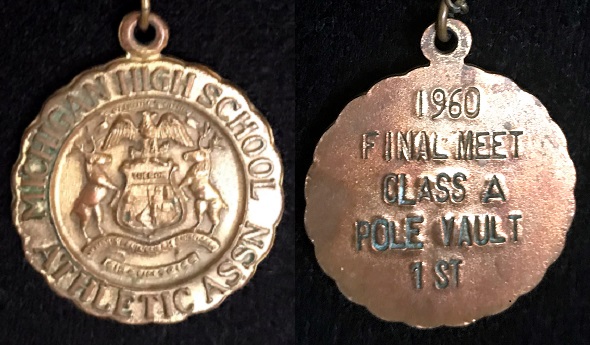
60 Years Later, Co-Champ Rediscovered
March 25, 2020
By Ron Pesch
Special for Second Half
Nicholas “Mickey” Turcheck tells a wild story. It involves a coin flip.
Involved in track & field for much of his life, Turcheck was a pole vaulter at Taylor Center during his high school days, then at Western Michigan University. He later served Taylor Center for more than three decades as track coach, where he mentored five state champions.
He also coached two future Olympians. Earl Jones, who won MHSAA Finals track titles in both 1980 and 1981, and grabbed bronze in the 800 meters at the 1984 Summer Olympics in Los Angeles. Another of his athletes, Deby LaPlante, qualified for the 1976 Summer Olympics in Montreal as a high hurdler.
In Turcheck’s possession is a medal. Etched on the back, pounded out in the style of the time, are five lines.
1960
FINAL MEET
CLASS A
POLE VAULT
1ST
Those 31 characters honor his MHSAA championship performance on what became a windy day in Ann Arbor at University of Michigan’s old Ferry Field.
But there is one problem. Turcheck’s name doesn’t appear on the MHSAA list of Finals champions. According to the list, the championship belongs to Joe Baldy of Monroe.
(The list has since been corrected and amended, per the story to be told below.)
Trackheads
For ‘trackheads’ – diehard fans of the sport and the events that comprise a track meet – as well as sports historians, a newspaper’s agate page is nirvana. Contained within the tiny type are the details that aren’t always relayed within the article covering a sporting event. Things like baseball batting averages, league standings, box scores, stat lines, team transactions, TV and radio schedules, and most everything else that doesn’t fix conveniently into the day’s sports section might appear on the page. For a track meet, a full agate listing will include place finishes as well as times, heights and distances that were used to determine winners of events, as well as detail on record performances that were equaled or topped.
Jim Moyes is a passionate sports fan. An undersized high school athlete at a small school, where participants of all shapes and sizes are valued, Moyes was the son of a prep coach at North Muskegon High School. He grew up and became, among other things, a beloved and respected broadcaster and public address announcer. Few were as well-prepared as Moyes, who studied agate pages, past performances, and, it seemed, the family trees of the participants prior to sitting before a microphone. His knowledge, as well as his sense of humor, was on display for 43 years in West Michigan, where he would balance his understanding and importance of an event with the awareness that, in the end, what we were experiencing was still just a game.
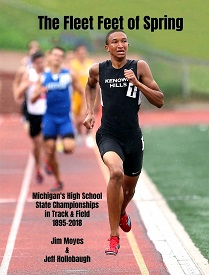 Well over 30 years ago he began his research into a passion project. Moyes is a ‘trackhead.’ And, because of this, in 2019, he officially became the author of a published book.
Well over 30 years ago he began his research into a passion project. Moyes is a ‘trackhead.’ And, because of this, in 2019, he officially became the author of a published book.
Way back, Moyes began digging into microfilm with the goal of capturing the names and events behind each MHSAA Finals track championship. He shared his initial research with the MHSAA, and for years the Association has highlighted his work on its website with lists of individual state champions on both their boys and girls track pages.
A couple of years before wrapping up his research, Moyes began work with another certified ‘trackhead,’ Jeff Hollobaugh – associated editor of Track & Field News, the voice of countless track meets, and as Moyes states, an “expert on this great sport” – to tell the stories of the meets in book form. “The Fleet Feet of Spring” – a history of Michigan’s High School State Championships covering the span 1895-2018 – was the result.
That’s 24,446 state champions. Simply put, its 439 pages contain a marvelous collection of statistics, stories and images.
But, with good reason, Turcheck’s name doesn’t appear in the publication.
Golden Age of Newspapers
Post-event press coverage on the 1960 MHSAA State Track Meet for most readers across Michigan arrived in their newspaper courtesy of coverage by wire-service reporters from The Associated Press or United Press International. With four meets to cover that encompass hundreds of prep athletes, the arch of the stories generally focus on record-setting events and streaks of success.
In Class A, the story was focused on the Pontiac Central squad that slipped past Flint Northern, 44-41, for its fifth title in six years. It was the seventh year in a row that the Vikings finished second at the meet. Pontiac junior Bredell Pritchett’s 59-foot-5¾ toss of the shot exceeded the previous state mark by better than two feet. Northern’s Maurice Pea, clocked at 9.8 seconds, tied a 35-year-old mark in the 100-yard dash. Al Ammerman of Dearborn established a new high jump record.
In 1960, the details of the pole vault simply weren’t the story.
Available space in newspapers is dictated by advertising. That certainly is the case today, and was most certainly the case back in the glory days of newsprint. Decisions are made by sports editors and staff on the amount of space available, and what agate will be printed. The results of a track meet, let alone the four simultaneous meets that comprise the MHSAA state championships, can certainly eat up plenty of real estate.
Relatively few papers around Michigan dedicated space to the MHSAA Track Championships back in May 1960. The old Detroit Times is among those that did include agate. Study of the listing however provides little clarity, as the paper listed only Metro Detroit finishers beyond the event winners. For the pole vault, that means confusion.
Pole Vault – “1 Joe Baldy, Monroe: Mickey Turcheck. Taylor Center: Bob Davis. Redford Union. and Larry Richardson. Livonia Bentley. were among those tieing for fourth. Distance 12 feet, 9 inches.”
The Grand Rapids Press agate adds haze to the mix. Baldy is listed in first, but Turcheck is listed as finishing second, followed by Flint Northern’s Jerry Wright in third. Davis, Richardson, Mike Pedler of Muskegon, J. Best from Battle Creek Central and Bill King of Traverse City are listed as occupying fourth place
The Battle Creek Enquirer lists only Baldy as the winner of the event and John Best “tied for fourth.” The Lansing State Journal agate shows only Baldy as the event winner. No track agate appears in the Detroit Free Press. Although the paper notes that team-wise, Birmingham finished third with 18 points, followed by Dearborn, Ann Arbor, Muskegon and Saginaw Arthur Hill in its coverage, the results from the Class A pole vault are not mentioned.
The Traverse City Record-Eagle does not include agate, but the article notes King’s fourth place finish, and that the Trojans track team spent the night sleeping on tumbling mats in the Saginaw Arthur Hill gymnasium when its bus broke down on the return trip home from Ann Arbor.
So, with little surprise, Moyes’ research concluded Baldy was the 1960 Class A pole vault champion.
Story of the Medal
In early March, Tony Mifsud, a longtime track coach at Dearborn Divine Child, contacted MHSAA Director of Broadcast Properties John Johnson about the story.
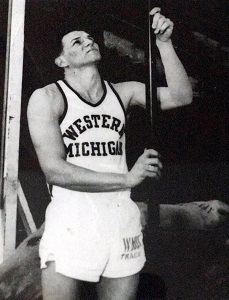
Turcheck was recently visiting a friend, Bob Parks, the head track coach at Eastern Michigan University for 34 years and an assistant track coach at Western Michigan during Turcheck’s time in Kalamazoo competing for the Broncos. On a visit this past fall, Parks mentioned the Moyes and Hollobaugh book that he had recently received.
“Mick, your name is not listed there,” said Parks. “I know you were tied for the state championship because I was the coach at Redford Thurston at that time and I was at the state meet. I remember you being announced as the co-state champion of the pole vault.”
“I said, ‘Really?’” recalled Turcheck from his home in Taylor.
After the visit, he made a couple of phone calls to friends. In turn, some of those folks began reaching out to others with the story.
According to Turcheck, after the pole vault was over, a meet official said they only had one medal and they were going to flip to determine who would receive it. Turcheck won the coin flip and was awarded the souvenir. A duplicate medal was to be mailed to his co-champion.
Newsprint and the Miracle of Microfilm
Before the days of smartphones, e-mail, websites, pop-up ads, and cloud storage, the history of cities, big and small, was captured in print and sold on street corners, at newsstands, and, beginning in 1947, by coin-operated vending machines.
Monthly subscriptions meant home delivery of the day’s news, and newspapers were everywhere.
Before Craigslist and Google Ads, there was money to be made in helping businesses advertise their wares, employers to advertise job openings, and for individuals to sell items and offer apartments for rent in the classifieds. That strong revenue stream supported large staffs and solid coverage of local events at daily and weekly newspapers.
Some of that content – that history – is slowly coming online, but most of it remains tucked away on microfilm and microfiche in local libraries across America.
And sometimes, local pride resulted in details about the exploits and accomplishments of area athletes to appear in smaller town publications that cannot be found elsewhere.
Niles Kruger, a sportswriter at the Monroe Evening News, followed up on a request by Johnson to check microfilm from newspapers in the area for any detail that might exist. Fortunately, the coverage in the Evening News appears to help clear up much of the story.
The article also illustrates an issue often injected upon microfilm by small agate-style typeface. Characters can often bleed or blur and appear to be other letters. A lower case ‘s’ can look like an ‘a’ or an ‘e’; a lower case ‘i’ can look like lower case ‘l.’ Unexpectedly, this, too, was illustrated here.
And sometimes, long lists are subject to other errors.
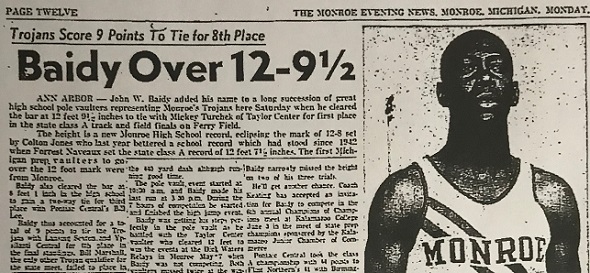
‘Baidy’ not ‘Baldy, ‘John’, not ‘Joe’
“ANN ARBOR - John W. Baidy added his name to a long succession of great high school pole vaulters representing Monroe’s Trojans here Saturday,” stated the Evening News, “when he cleared the bar at 12 feet 9 ½ inches to tie with Mickey Turcheck of Taylor Center for first place in the state Class A track and field finals on Ferry Field …”
“Baidy also cleared the bar at 6 feet 1 inch in the high (jump) to gain a two-way tie for third place with Pontiac Central’s Bill Lee. Baidy thus accounted for a total of 9 points to tie the Trojans with Lansing Sexton and Ypsilanti Central for 8th place in the final standings.”
While there is no mention of the flip for the metal, the article backs up Turcheck’s recall of the day.
Recognizing that despite their best efforts, Moyes and Hollobaugh know that errors can appear in the publication. In their “Notes to the reader” section, they ask readers to please make contact if any mistakes are spotted.
“Thanks to today's modern technology Jeff Hollobaugh will be able to make the appropriate corrections in our book” noted Moyes from Florida via email, noting the marvels of the times we live in. “Better yet for Jeff & I,” added Moyes, displaying his comedic style, “with the amended corrections maybe Mickey Turcheck will purchase our newly revised book.”
Search for Baidy
“They wanted to flip a coin,” said Baidy recently, surprised in the sudden interest in a day from so many years ago and chuckling at the memory. “He got the call and got the medal. I really don’t remember if they told me if I was supposed to get a medal (in the mail). Right after that I had to go to the high jump or something.”
Baidy – who also tied for the Class A Finals high jump championship in 1959 – had received a call earlier on this day from his long-ago opponent from Taylor Center.
“I would certainly like to meet him again,” said Turcheck. His former high school sweetheart and bride had used her smartphone to seek out Baidy’s contact information, and soon after, the two old athletes were reminiscing about the day. Turcheck pitched the idea of getting together for lunch or dinner sometime soon.
“That’s what he wants to do, and it’s all right with me,” Baidy said, noting plans after things settle down. “We’re lucky to still be alive.”
 Ron Pesch has taken an active role in researching the history of MHSAA events since 1985 and began writing for MHSAA Finals programs in 1986, adding additional features and "flashbacks" in 1992. He inherited the title of MHSAA historian from the late Dick Kishpaugh following the 1993-94 school year, and resides in Muskegon. Contact him at [email protected]:void(0);t with ideas for historical articles.
Ron Pesch has taken an active role in researching the history of MHSAA events since 1985 and began writing for MHSAA Finals programs in 1986, adding additional features and "flashbacks" in 1992. He inherited the title of MHSAA historian from the late Dick Kishpaugh following the 1993-94 school year, and resides in Muskegon. Contact him at [email protected]:void(0);t with ideas for historical articles.
PHOTOS: (Top) The 1960 Finals championship medal, front and back, awarded to Baidy. (2) The Fleet Feet of Spring has been revised based on the latest re-discovery of a co-championship. (3) Mickey Turchek went on to compete at Western Michigan. (4) The Monroe Evening News announced John Baidy’s championship pole vault as part of its coverage of the 1960 Class A Track & Field Finals. (Turchek photo courtesy of the Turcheck famly; newspaper clipping courtesy of the Monroe Evening News.)
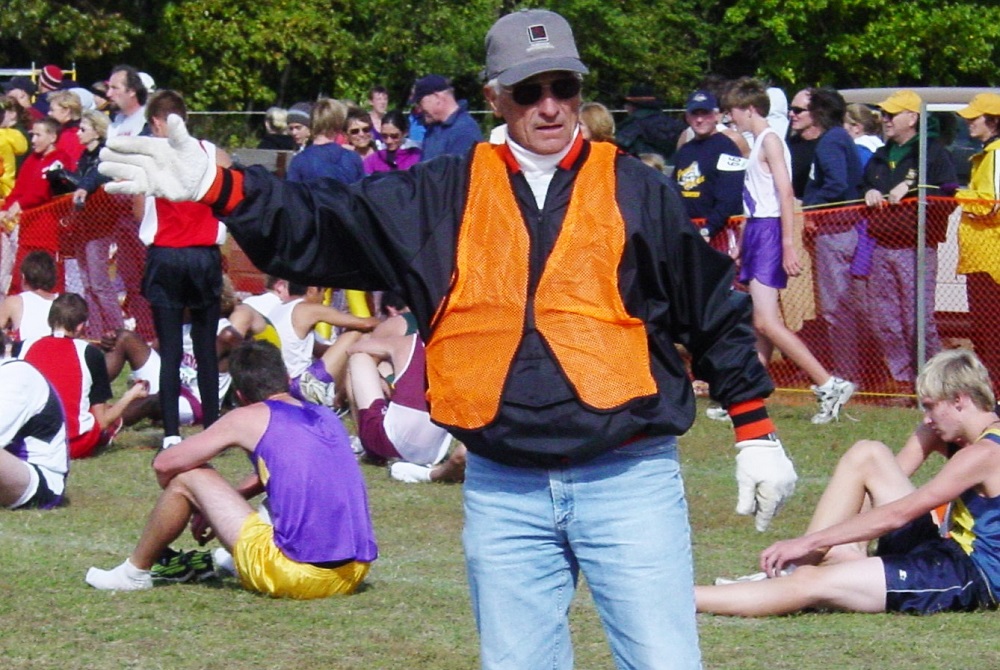
Jackson's Janke Recalled as 'Larger than Life,' Always Willing to Help
By
Doug Donnelly
Special for MHSAA.com
January 26, 2022
JACKSON – A few days before Christmas, Jackson boys track & field head coach Corey Pryor was called to meet with Charles Janke, the longtime former Jackson coach and teacher.
 Janke was very ill and in the final days of his life. Janke, it turns out, wasn’t leaving anything to chance.
Janke was very ill and in the final days of his life. Janke, it turns out, wasn’t leaving anything to chance.
“He asked me if the stadium was ready for our big track meet, the one named after him,” Pryor said. “Believe it or not, that’s what he asked. He was always so organized and meticulous. He wanted to make sure everything was always on schedule.
“I am grateful for getting the chance to spend a few more moments with him.”
Janke, 85, died Dec. 30 at Henry Ford Allegiance Hospice Home in Jackson.
Janke was a track and cross country coach for Jackson who was recognized statewide for his commitment to high school athletics, student athletes and the two sports he loved the most. Although he retired from coaching nearly two decades ago, he remained very involved in high school sports. He was a leader in both sports across the state, a giant in the high school running community.
A Detroit native who went to Central Michigan University to play football, Janke had short stints at Southfield and Milford schools before moving to Jackson where he taught history and physical education. Although he got his start as a football coach, at Jackson he took over the track and cross country programs in 1966. He pulled double duty for years before stepping down as track coach in 1990, but he continued with cross country through 2003 while helping coach the distance runners in track for several more years.
If it involved track & field or cross country in Michigan, Janke was probably involved. He was an early pioneer in the Michigan Interscholastic Track Coaches Association, the first statewide sports-specific association for coaches in the state. He founded several events, including the first countywide cross country meet in Jackson. He hosted, organized and gave presentations at coaching clinics for years and in the early 1970s helped organize indoor track & field meets through MITCA by contacting colleges across the state to see if they were interested in hosting events. He also was the first to publish a MITCA newsletter.
In cross country, he was among those who played a role in bringing all four classes together for a Lower Peninsula championship meet at Michigan International Speedway in Brooklyn. He helped with the event long after coaching. He also served as head field events judge at Big Ten Indoor Championships and became a high school official after retiring as head coach.
His passion for the sport was evident.
“He had a genuine love for the sport,” Pryor said. “He always had his way of doing things. He was a special kind of guy.”
When Pryor was a high school sprinter at Jackson, Janke was an assistant coach who mainly worked with long distance runners.
“He coached hard,” Pryor said, adding that he never fully appreciated Coach Janke until later in life and especially after he became track coach. Pryor found pages and pages of handwritten notes with dates, times and athletes’ names.
“He even wrote down the weather,” Pryor said.
He and Janke had a lot of discussions, often over breakfast, about track events.
“He would be at almost all of the meets,” Pryor said. “He learned every kid by name. He told them he wanted to see them at the state meet. I welcomed him with open arms. When I began to see just what he meant to our state, I realized this guy was a diamond.
“I was blessed to see him behind the curtain. I saw he was the type of guy who really cared about people and wanted to see them succeed. He was more than a coach.”
Vandercook Lake cross country coach Dan Roggenbaum is one of several from the Jackson area who would seek out Janke for advice and mentorship. He said Janke approached officiating with the same rigor and commitment he did coaching.
“Charlie was always willing to help me out with any questions I ever had,” he said. “He was larger than life to me and most other coaches in our county. He was always willing to help and give advice to any of us who were a lot newer to the cross country and track & field scene.”
Two things Janke was most proud of was Withington Stadium in Jackson and the cross country course at Ella Sharp Park named after him.
“I always admired his love and passion for cross country, track & field,” said Ben Pack, now a coach and administrator at Manchester, but once a shot and discus thrower for Janke. “On days of track meets he would have the track set up before the school day started, with the blocks at the starting line, the hurdles stacked along the track to be placed for the first hurdle race, and the throws event areas lined. Every detail for the practices and meets were paid attention to.
“He didn’t do this because he had to do it; he did it because he loved doing it. He always wanted everything to be first class.”
Janke was admittedly a tough coach.
In winning the Al Cotton Award for his dedication to Jackson athletics, the Jackson Citizen-Patriot wrote this about Janke in 2003: “One does not need to talk to many of Janke's athletes or listen very long to get a clear picture of the type of coach he was. He was intense. He was in charge. He demanded respect and he expected the best, and he received a huge measure of both from those who followed his regimen.”
Janke was inducted into both the Michigan High School Coaches Association Hall of Fame and the MITCA Hall of Fame.
Pack said, “During high school we had a sign that read, ‘The mind controls the body.’ In PE strength class we often did exercises that helped us understand how much more we could push ourselves if we fought off the pain of the exercise. Without question, this built mental toughness. He taught kids how to set goals, and the step-by-step process to get to the goal.”
All told, Janke spent more than 60 years involved in track and cross country. His impact will roll on in both sports. A number of former athletes have gone on to become teachers and coaches themselves, like Pack, who not only was an athlete for Janke but coached alongside him. Pack served as Jackson’s varsity football coach from 1987-2002 and again in 2012.
“As peers we often would guide kids to each other’s sports,” Pack said. “Kids that I felt would be better at running cross country, I sent to him. Kids that he felt would be good football players he sent to me. Working together was an honor.”
Jim Martin ran for Janke at Jackson in the 1970s. He’s now in his 36th year coaching track and cross country, the last 26 at Sault Ste. Marie High School. He said he’s a coach today because of the impact Janke had on him.
“At a time in my life that I needed structure and guidance, he was the rock,” Martin said. “He was always there. There's no way I'm in this (coaching) 35 years without him. He was my role model. He cannot be replaced.”
Last fall, Martin took his Sault Ste. Marie team to Jackson for the Charles Janke Invitational. His Blue Devils team won. Going into the meet, he didn’t think that was possible.
“For the life of me I couldn’t figure out how we won that,” Martin said. “We were good, but not Jackson good. … That was the last time Coach Janke saw my team. Now I know why.”
A Celebration of Life service will be held at 2 p.m. on June 12, 2022, at, appropriately, Withington Stadium.
 Doug Donnelly has served as a sports and news reporter and city editor over 25 years, writing for the Daily Chief-Union in Upper Sandusky, Ohio from 1992-1995, the Monroe Evening News from 1995-2012 and the Adrian Daily Telegram since 2013. He's also written a book on high school basketball in Monroe County and compiles record books for various schools in southeast Michigan. E-mail him at [email protected] with story ideas for Jackson, Washtenaw, Hillsdale, Lenawee and Monroe counties.
Doug Donnelly has served as a sports and news reporter and city editor over 25 years, writing for the Daily Chief-Union in Upper Sandusky, Ohio from 1992-1995, the Monroe Evening News from 1995-2012 and the Adrian Daily Telegram since 2013. He's also written a book on high school basketball in Monroe County and compiles record books for various schools in southeast Michigan. E-mail him at [email protected] with story ideas for Jackson, Washtenaw, Hillsdale, Lenawee and Monroe counties.
PHOTO: Charles Janke coaches his Jackson team during a cross country meet in 2003. (Photo by John Johnson.)

